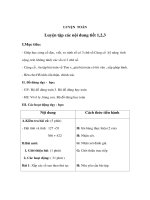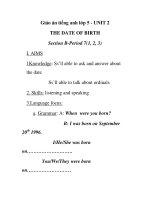- Trang chủ >>
- Mầm non - Tiểu học >>
- Lớp 5
5 4 3 changing to survive bird adaptations TG
Bạn đang xem bản rút gọn của tài liệu. Xem và tải ngay bản đầy đủ của tài liệu tại đây (151.06 KB, 4 trang )
Changing to Survive:
Bird Adaptations
SUMMARY
This book surveys various birds
from around the world. It identifies and
describes different bird groups, including sea
birds, shore birds, birds of prey, and song
birds. It describes their habitats, eating habits, behavior, and physical make-up.
LESSON VOCABULARY
critical
mucus
specialize
enable
scarce
sterile
INTRODUCE THE BOOK
INTRODUCE THE TITLE AND AUTHOR
Discuss with
students the title and the author of Changing
to Survive: Bird Adaptations. Based on the
title, ask students what information they think
this book will provide.
BUILD BACKGROUND
Invite students to share
what they know about birds. Ask if anyone has
owned a bird. What sorts of bird behaviors
have students observed? Ask what it is about
birds that students find interesting. Introduce
the word “adaptation.” Ask students what they
think this word means. You may wish to tell
them that birds or animals adapt by changing
or adjusting to a special situation.
Encourage English language learners to
share names of birds in their home languages.
PREVIEW/USE TEXT FEATURES
Have the students
look at the photographs, captions, maps, and
headings in the book. Ask students what they
notice about the way this book is organized.
What other text features do the students
recognize? How do they think the maps can
help them understand more about what
they’re reading?
5.4.3
GRAPHIC SOURCES
MONITOR AND FIX UP
READ THE BOOK
SET PURPOSE
Have students set a purpose for
reading Changing to Survive: Bird Adaptations.
Their interest in birds and animals and in
environmental issues may drive this purpose.
Students may continue to add questions and
answers to their KWL charts.
STRATEGY SUPPORT: MONITOR AND FIX UP
Encourage students to monitor their comprehension by asking questions as they read.
(Do I understand this? Does this make sense?)
Sometimes their questions will be about
things they want to learn. They may add these
questions to their KWL charts. If students are
having comprehension difficulties, encourage
them to use a fix-up strategy, such as reading
on, rereading and reviewing, or seeking help
from others.
COMPREHENSION QUESTIONS
PAGES 4–5 How have birds evolved into “flying
machines”? (Wings and bodies covered with
feathers, lightweight bodies, eat a lot for energy.)
PAGES 6–7
What do these photos show you?
(Possible responses: Birds live in many different
areas. There are many types of birds.)
PAGES 10–11
What is the main idea? What
are the supporting details? (Shore birds have
adapted in different ways to life along the
shore. Some have long, pointy beaks for
digging and long, thin legs to keep bodies
above water. Others have short beaks and
legs because they eat above the water.)
PAGE 14
What are some of the owl’s special
adaptations? (Possible responses: Nocturnal,
huge eyes in front of face, can rotate head
almost all the way around, soft feathers help
make them silent flyers.)
PAGE 22
What are some challenges that birds
face? (Possible responses: growing cities, pollution, cutting down forests, destroyed habitat)
80
Changing to Survive: Bird Adaptations
16917_LRD_TG_080-081 80
6/16/06 12:13:53 PM
REVISIT THE BOOK
READER RESPONSE
1. The author uses each caption as a heading
for the pages that follow.
2. Possible response: Shore birds and water
birds have both similarities and differences.
Shore birds spend a lot of their time in shallow water, while water birds are good swimmers. Both types of birds may use their
beaks or bills to obtain food and other types
live in many different regions of the world.
3. Thick, sticky liquid; makes insects stick
to tongue.
4. Responses will vary.
EXTEND UNDERSTANDING
Have students think
about what their understanding of this text
would be like if the book contained no
photographs. Discuss how the photographs
help make some of the points presented in
the text much more vivid.
RESPONSE OPTIONS
WRITING
Encourage students to pick a favorite
bird from Changing to Survive. Have them
write a poem about the bird. They should
include facts they learned from the book in
their poems.
SCIENCE CONNECTION
How have other animals adapted
to their environments? Have
students choose an animal to
research. Encourage them to pay special
attention to how the animal has adapted to
its habitat.
Skill Work
TEACH/REVIEW VOCABULARY
Have students locate the vocabulary words
in the text. Have them define each word
using context clues, the glossary, and a dictionary. Then, invite students to list for each
word as many words as possible that have
similar meanings or are related in some way.
TARGET SKILL AND STRATEGY
GRAPHIC SOURCES Remind students
that graphic sources are graphs, maps,
pictures, photographs, and diagrams that
help strengthen their understanding of the
text. Students may also use graphic sources
before reading to predict and preview information. Have students create a KWL chart.
They should list what they already know
about birds and what they want to know.
MONITOR AND FIX UP Remind students
that good readers constantly monitor, or
check, comprehension as they read. If
the text isn’t making sense, they can use
fix-up strategies, such as adjusting reading
rate, reading on, or rereading and reviewing.
Have students read page 3. Encourage
them to practice the fix-up strategies
mentioned. Discuss which strategy worked
best and why.
ADDITIONAL SKILL INSTRUCTION
MAIN IDEA AND DETAILS
Remind students
that the main idea is the most important
idea about a topic. It is usually stated very
briefly. The supporting details are small
pieces of information that tell more about
the main idea. Have students read page 3.
Ask them to tell you what the main idea is.
(Birds live all over the world.) Ask students
to tell you some supporting details. (Birds
have adapted to many different habitats—
deserts, forests, Antarctica—to be able to
live in so many places.)
Changing to Survive: Bird Adaptations
16917_LRD_TG_080-081 81
81
10/20/05 2:14:48 PM
Name
Changing to Survive
Graphic Sources
Graphic sources are graphs, maps, pictures, photographs, and diagrams that help strengthen
understanding of text.
© Pearson Education 5
Directions On the map below, show the ranges of the birds you learned about in the book. Include a
title and a key.
82
16917_LRD_TG_082-083 82
10/20/05 2:15:25 PM
Changing to Survive
Name
Vocabulary
Directions Fill in the missing spaces in each sentence below with the correct word from the “Words
to Know” box and an appropriate word from the “Birds to Know” box. You may refer to your reader
for information about the birds.
Check the Words
You Know
critical
enable
mucus
scarce
specialize
sterile
1.
Birds
to Know
penguins
pelican
woodpeckers
ostriches
have a special
on their tongues for snatching up
insects to eat.
2.
live in an environment where food is
They have to walk a long way in search of food.
have adapted flippers in place of wings that
3.
.
them
to swim underwater.
has the longest beak of any bird. It allows it to
4. The
in fishing by scooping fish from the water.
© Pearson Education 5
5. Scientists who work with baby birds keep them in a
stay healthy.
6. When birds are endangered, bird conservationists feel it is
them.
environment so they
to help save
83
16917_LRD_TG_082-083 83
11/18/05 9:45:36 AM









